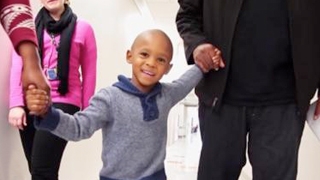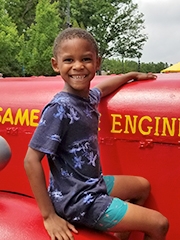Tajh’s Story: Medical and Surgical Treatment of Myasthenia Gravis
Published on
Published on
For 10 years, Niya had worked for the Environmental Services Department at Children’s Hospital of Philadelphia (CHOP), keeping the hospital clean and safe for families as they coped with the stress of their child’s illness. She never thought she’d need the same support one day, for her own family.
 Tajh was a healthy, active kid who loved to run, jump, throw and kick balls, climb things, and enjoy all the fun activities of childhood. His family went running pretty regularly on a track at a school near their home in Mount Airy, a neighborhood in Northwest Philadelphia. But the summer before Tajh was supposed to start preschool, his activity level suddenly decreased. On trips to the track, he seemed too tired to run.
Tajh was a healthy, active kid who loved to run, jump, throw and kick balls, climb things, and enjoy all the fun activities of childhood. His family went running pretty regularly on a track at a school near their home in Mount Airy, a neighborhood in Northwest Philadelphia. But the summer before Tajh was supposed to start preschool, his activity level suddenly decreased. On trips to the track, he seemed too tired to run.
His parents, Niya and Lamont, thought he was just being lazy. Then, at the end of the summer, Tajh was playing outside when he fell and hit his face on the steps of their home. After the fall, his left eye looked different; like he had a lazy eye. When the condition began to affect his other eye, too, Niya and Lamont grew concerned.
They took Tajh to their local pediatrician who referred them to an eye doctor. When the eye doctor suggested Tajh see an ophthalmologist at Children’s Hospital of Philadelphia (CHOP), Niya felt reassured. As a CHOP employee for 10 years, she had heard many testimonials about the doctors being very thorough and knowledgeable.
After evaluating Tajh, the CHOP ophthalmologist suspected myasthenia gravis, an autoimmune neuromuscular disease in which the nerves and muscles are unable to communicate properly. The ophthalmologist referred the family to John Brandsema, MD, a CHOP neurologist, who performed a blood analysis that confirmed the diagnosis.
The immune system typically functions to protect the body from foreign organisms. But in myasthenia gravis, the immune system is overactive and creates abnormal antibodies that disrupt the connection between muscles and nerves, producing muscular weakness. Drooping eyelids and double vision are typically the first symptoms of the condition, but other symptoms can include clumsiness, difficulty breathing, tiring easily, falling easily, and difficulty speaking, swallowing and chewing. The condition is rare, especially in children; of the 10 in 1 million people diagnosed with it annually, only 10 percent are children. There is no cure for the condition, and symptoms usually get worse over time.
“I was in complete shock,” recalls Niya. “I felt many emotions at one time. I was fearful, sad, worried, confused. I had so many questions: How did this happen to my child out of the blue? Did he contract it from someone? Is it hereditary? Now what?”
Dr. Brandsema answered them all and explained that the goal of treatment is to get kids with myasthenia gravis to a place where they have little or no symptoms for the rest of their lives. The earlier patients are treated, the better they do.
Dr. Brandsema, working in collaboration with pediatric neuro-ophthalmologist Grant Liu, MD, first prescribed Mestinon®, a medication that can help improve communication between the nerves and muscles. But Tajh continued to have eye droopiness and was hit hard by gastrointestinal upset, a known side effect of the drug. He was further treated with prednisone, a corticosteroid that can inhibit the immune system’s production of antibodies, and the family finally saw their active little boy return.
“He could open both eyelids and his energy returned,” says his mom.
Still, Tajh had periods where his symptoms would come back full force. Niya remembers one very scary moment.
“Neither of his eyes would open and I could tell he was struggling to open them,” she recalls. “He was scared and I was trying my best not to freak out to keep him calm.”
Niya quickly called Dr. Brandsema who increased Tajh’s prednisone dosage, and within a few hours Tajh was finally able to open his eyes. While upping his dose worked in the short term, prolonged use of corticosteroids can have serious side effects — including decreased bone growth and obesity — so the solution wasn’t ideal.
Tajh’s medical team turned to a more long-term treatment plan: thymus removal. In myasthenia gravis, the thymus, an immune organ located in the chest, is thought to incorrectly influence the immune system. Some patients improve when the thymus is removed. But the effects can sometimes take weeks to years to occur, and some children see no benefit.
At CHOP, a combination of medical and surgical treatment is often the preferred plan to offer the best chance of remission. CHOP has completed more procedures to remove the thymus in the pediatric population than any other hospital in the nation. There is a dedicated care team with providers from General Surgery, Neurology and Neuro-Ophthalmology who work together to optimize the peri-procedural management.
When Tajh was 5 years old, attending pediatric surgeon Thane Blinman, MD, performed a minimally invasive procedure to remove Tajh’s thymus. So far, Tajh’s symptoms haven’t gone away, so he continues to take Mestinon and low-dose prednisone. He has not yet required other immune-modulatory treatments sometimes indicated in myasthenia gravis.
 Today, Tajh is a bubbly, happy 7-year-old boy. He just finished first grade, loves math and is a straight-A student. He has regained a lot of his energy, but he tires faster than other kids. He likes to go outside and play football with his friends until he’s worn out, and then likes to play video games or watch YouTube videos.
Today, Tajh is a bubbly, happy 7-year-old boy. He just finished first grade, loves math and is a straight-A student. He has regained a lot of his energy, but he tires faster than other kids. He likes to go outside and play football with his friends until he’s worn out, and then likes to play video games or watch YouTube videos.
“He’ll complain about leg pain and his joints hurting, whether it’s his hands or his feet, more at the end of the day,” says his mom. “That’s what’s hardest for me. I can’t take away his pain.”
He comes to CHOP for follow-up every three months or so. The plan is to monitor Tajh and adjust his medications to achieve as close to a symptom-free daily life as possible while minimizing treatment side effects. In the meantime, research continues at CHOP and elsewhere, including research trials of new medications, to find additional treatments for myasthenia gravis.
“I pray they can find a cure,” says Niya. Her advice to other parents who receive the diagnosis is: